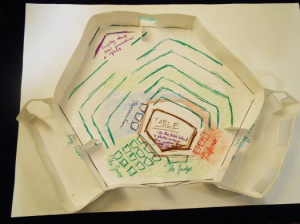 ArchDaily accompanied their interview of VanBuren with this photo, a redesign of a courtroom from one of VanBuren’s workshops courtesy of FOURM Design StudioThis piece caught my attention for a number of reasons, not least because it comes from such a surprising and fresh direction. In a recent article titled "Restorative Justice: An Interview with Deanna VanBuren," ArchDaily, a trade publication for architects and designers, notes that the group Architects, Designers and Planners for Social Responsibility (ADPSR) "is campaigning to have the [American Institute of Architects] forbid its members from designing prisons" as a form of protest against the punitive U.S. penal system.
ArchDaily accompanied their interview of VanBuren with this photo, a redesign of a courtroom from one of VanBuren’s workshops courtesy of FOURM Design StudioThis piece caught my attention for a number of reasons, not least because it comes from such a surprising and fresh direction. In a recent article titled "Restorative Justice: An Interview with Deanna VanBuren," ArchDaily, a trade publication for architects and designers, notes that the group Architects, Designers and Planners for Social Responsibility (ADPSR) "is campaigning to have the [American Institute of Architects] forbid its members from designing prisons" as a form of protest against the punitive U.S. penal system.
But the editors are pleased to have discovered the work of Deanna VanBuren of FOURM Design Studio, who says she is looking at "the question of how architects might actually change the system." Amazingly, she is doing so by looking at prison and court design through the lens of restorative justice and restorative practices.
In the interview, VanBuren explains that she and her partner, Barb Toews, are "currently engaging with the public on the issues of restorative justice, design and incarcerated spaces" at a number of national conferences, including the IIRP 16th World Conference in October.
VanBuren says that she and Toews, a PhD candidate in social work at Bryn Mawr, are doing design research in Chester Prison and various jails around Philadelphia. They also hope to run 2-day workshops at San Quentin and Graterford Prisons, on each U.S. coast.
"As part of the Public Interest Design movement my practice and partners are supporting these efforts," VanBuren says, "by locating non-profits such as The National Council on Crime and Delinquency or the Center for Court Innovation who have respected track records innovating within the system and outside of it. We ask them to team with us to create spaces for restorative justice and peacemaking as a holistic model for change."
VanBuren adds, "Ultimately we use billions of our tax dollars on our punitive justice infrastructure so I think it will be easy to make the case to deflect some of the money into creating new prototypes like opportunity network centers and restorative justice centers that will cost a fraction of the price and support a process that will reduce crime."
VanBuren and Toews will present "Peace Building: Architecture and design as a restorative practice" as a breakout session at IIRP's World Conference. About their session, they write:
"Restorative practices occurs in a myriad of spaces – schools, prisons, houses of worship, and homes – with facilitators striving to create a physical and psychological atmosphere that is safe and respectful of the person harmed, the person who harmed and community members, and is conducive to the restorative aims of the interaction.
"Research suggests that the physical and psychological environment impacts the way people feel, act, and even heal. This subsequently raises important questions about the design of spaces in which restorative practices occur and the way in which restorative justice values and principles can be applied to the architecture and design of restorative settings.
"Participants will explore restorative justice and its relationship to architecture and design, gain insight into how attention to design can support the restorative process and engage in a design thinking process to assist in the creation of spaces informed by restorative justice."
